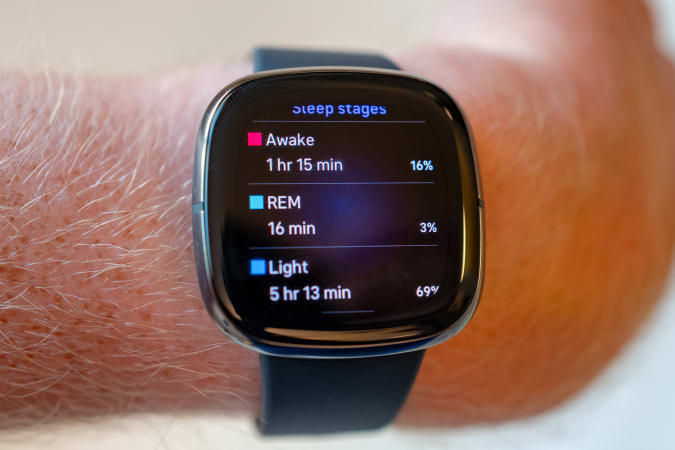
How gadgets could unlock the potential of lucid dreaming
[ad_1]
If you ever needed an excuse to get more sleep, exciting new findings about lucid dreaming could be it. A recent study has just proved that, in the right conditions, you can not only communicate with people in the lucid state, they can answer questions, too. Sure, the subjects only solved simple math questions (the kind most 8th graders could) but it provokes a tantalizing thought — what else can we do while we’re in slumberland?
Scientists communicating with lucid dreamers is nothing new, but the latest experiment dialed up the complexity of that communication, just enough, to renew the public’s interest in this mysterious activity.
For the uninitiated, lucid dreaming is realizing that you are in a dream and then being able to influence what happens within it. As simple as this sounds, it’s actually a tricky thing to do, and an even harder thing to study. But with this latest research, scientists are beginning to consider there might be tangible benefits we could tap into — something the community of avid dreamers has been suggesting for years.
Can we access parts of our mind that normally remain filtered during our waking life? Could we use this as a therapeutic tool? Could we even unlock some powerful learning tools? The answer seems to be tantalizing maybe. And technology might be the catalyst we need.
Research into lucid dreaming has its foundation in the ‘70s and ‘80s. In 1975 Dr Keith Hearne demonstrated it’s possible to communicate with lucid dreamers in an experiment where subjects repeated a predefined pattern of eye movements while asleep. Ten years later, Stephen LaBerge, a name now synonymous with the subject, was able to determine that our sense of time in the lucid dream state was the same as that of the waking world — hinting at a stronger relation between the lucid and waking state than we first might have suspected.

gorodenkoff via Getty Images
What we now have is a more direct “conversation” between the dreamer and the scientist, albeit somewhat limited to simple math and food likes/dislikes. “This opens up a lot of possibilities for dream research, of course, but also, there’s a lot of potential in all sorts of applications. If you think about it, our participants learned new knowledge during sleep.” Dr. Kristoff Appel, one of the study authors, told Engadget.
Of course, if popular culture has taught us anything, it’s that behind those heavy eyelids is when our inner genius comes out to play. “In the future, maybe we could use this for creative purposes, maybe connect the dream out to some machines to control robots, or maybe use it in creative space for creating art or music, compose some melodies maybe from dream. The Beatles song, ‘Yesterday’, is said to have composed or the idea came from a dream.” Appel added.
Now, don’t confuse this with something like those hypnosis audio tapes of yore. The kind that convinced Chandler Bing he was a strong, confident woman. Those programs claimed to speak to the subconscious, Appel and his colleagues were simply speaking to someone who also happened to be asleep. If you’re wondering, then, what actually defines being asleep from a scientific perspective, it’s a combination of measurable signals.
“You measure the brain activity, you measure the eye movements and the muscle tension. That’s classical so-called polysomnographic recording in the sleep laboratory. And from these recordings, you can definitely say objectively okay, this is awake, this is maybe REM sleep, this is a deep sleep, and so on,” according to Appel.
Kristen LaMarca, a clinical psychologist based in California, is even more enthusiastic about lucid dreaming’s potential. “It is a fantastic, just wildly imaginative, magical state. There’s so much positive emotion and beauty and some of this, we’ve actually quantified in research,” she told Engadget.
It’s not all just for flying around or visiting far away places, though. LaMarca uses lucid dreaming as a therapeutic tool, helping people overcome things like PTSD. “With PTSD, you’re already revisiting those scenarios in different aspects of your life,” she said. “So, the point of lucidity is to do that in a wiser way, a more conscious way.” Once patients are able to achieve lucidity, LaMarca said, they know that they are safe and that the situation isn’t real, thus better enabling them to process it.
You might well be asking yourself, “How do I achieve this ‘magical’ state?” The short answer is: With practise. There are many, many guides online on how to do this, but most of them revolve around two key ideas: Reality checks and dream signs. The former involves things like, counting the number of fingers on your hand (it can change in a dream) or using technology (which often doesn’t work in the land of nod). Dream signs, LaMarca’s preferred method, involves recognizing things that regularly occur in your dreams — like a recurring character or situation — as a way of triggering the awareness and, ideally, then being able to control it. “Another really great thing to focus on is your own thinking process as a dream sign itself. And this is ignored a lot in the literature. But your own thinking is a really great dream sign,” she added.
You’ll need more than just a trigger, though. There appears to be a strong link with memory recall ability and lucid ability. Which is why most guides will tell you to keep a dream journal and it’s also why PTSD sufferers might be particularly suitable candidates — given that they spend a lot of time recalling the same event in vivid detail. There are also some practical factors. Lucid dreams tend to happen toward the end of the sleep cycle, so some people intentionally wake themselves around two hours before they normally get out of bed and set an intention to go back to sleep and, hopefully, right into a lucid dream — a technique known as WILD.
If this all seems like a lot of work, there are some tools out there to help. Galantamine is a drug typically used to treat cognitive decline and alzheimers. Thanks to its effects on memory, it has been found to be useful in promoting lucid dreaming. In fact, LaMarca claims taking galantamine in the middle of the night and going back to sleep can put you in a state that’s conducive to having these long, full, very vivid, lucid dreams. Galantamine is available over the counter in the US, but is prescription only in most of Europe. Another supplement that’s claimed to help is Huperzine A, which generally doesn’t require a prescription. Of course, you should always check with your doctor before trying any new medication, prescription or otherwise.
This is where technology comes in. In a world full of sleep trackers and wearable silent alarms, we effectively already have tools that can, or so they claim, detect different stages of the sleep cycle and wake us up quietly. Used creatively, these gadgets could be a sort of lucid dreaming starter kit, right? According to Appel, we’re not quite there yet.

Smith Collection/Gado via Getty Images
“I would say until a few years ago, just all these sleep staging algorithms inside watches and all these also other devices, they were not reliable at all. And also there’s a lot of research papers about it showing that, for example, REM sleep and being awake can’t really be differentiated just from having a watch also recording your sleep. You need to analyze the brain activity for that, because the rest is not good enough to differentiate between.”
So, it turns out, that sleep-stage detection might not quite be accurate enough with the current wave of wearables. Although that doesn’t mean they can’t be useful for waking you for the WILD technique. It’s just not quite smart enough to automatically tell when you’re in the right type of sleep. Yet.
That hasn’t stopped a wave of smaller companies making all sorts of different types of gadgets that promise to hold the keys to the lucid kingdom. Just a cursory search on Kickstarter will reveal everything from wristbands, to headbands to eye masks. All of them promise to make achieving lucidity a cinch. Appel isn’t so confident.
“I tried out several of these, different of these Kickstarter things, and other lucid dream mask, and so on, and so far it doesn’t seem to work really well. And I think it will change over the next few years, I think there will be some maybe more sophisticated apps or devices and so on, but at the moment I don’t see a technical device that can induce lucid dreams reliably, unfortunately.”
LaMarca is also cautiously optimistic that we will be able to make effective devices for inducing lucid dreams, but it’ll need companies to work with scientists to get it right. “I’d like to see more interdisciplinary collaboration in order to get that going more, but it is a shame because there really is a lot of potential to help use technology to help us lucid dream more.”
Fancy wearables might not be the only way technology can help us get lucid. There are many apps that also make bold claims about tipping you off that you’re dreaming. These might actually be a little more practical, for now. Awoken (Android) and Lucidity (iOS) for example operate more like training tools that leverage some of the tech in your phone. Every morning you can add to your dream journal and throughout the day they’ll prompt you to check that you aren’t sleeping (the idea being this test will carry over into your dreams). Some apps also let you set a “trigger” sound — a low volume audio cue that helps you lurch out of passive dreaming into the active.
Whatever method you might choose, be it the classical reality checks, supplements, gadgets or apps, there’s definitely a lot that can be learned and not just for scientists. For many, the real allure is the rare access to your own mind, as Appel can attest. “I’ve tried it myself, talking to your subconscious, and asking the dream a question and it answers. So there’s lots of interesting things that you can try out in your lucid dreams, and also a lot that you can learn about yourself, in my opinion, with these self questions.”
[ad_2]
Source link







